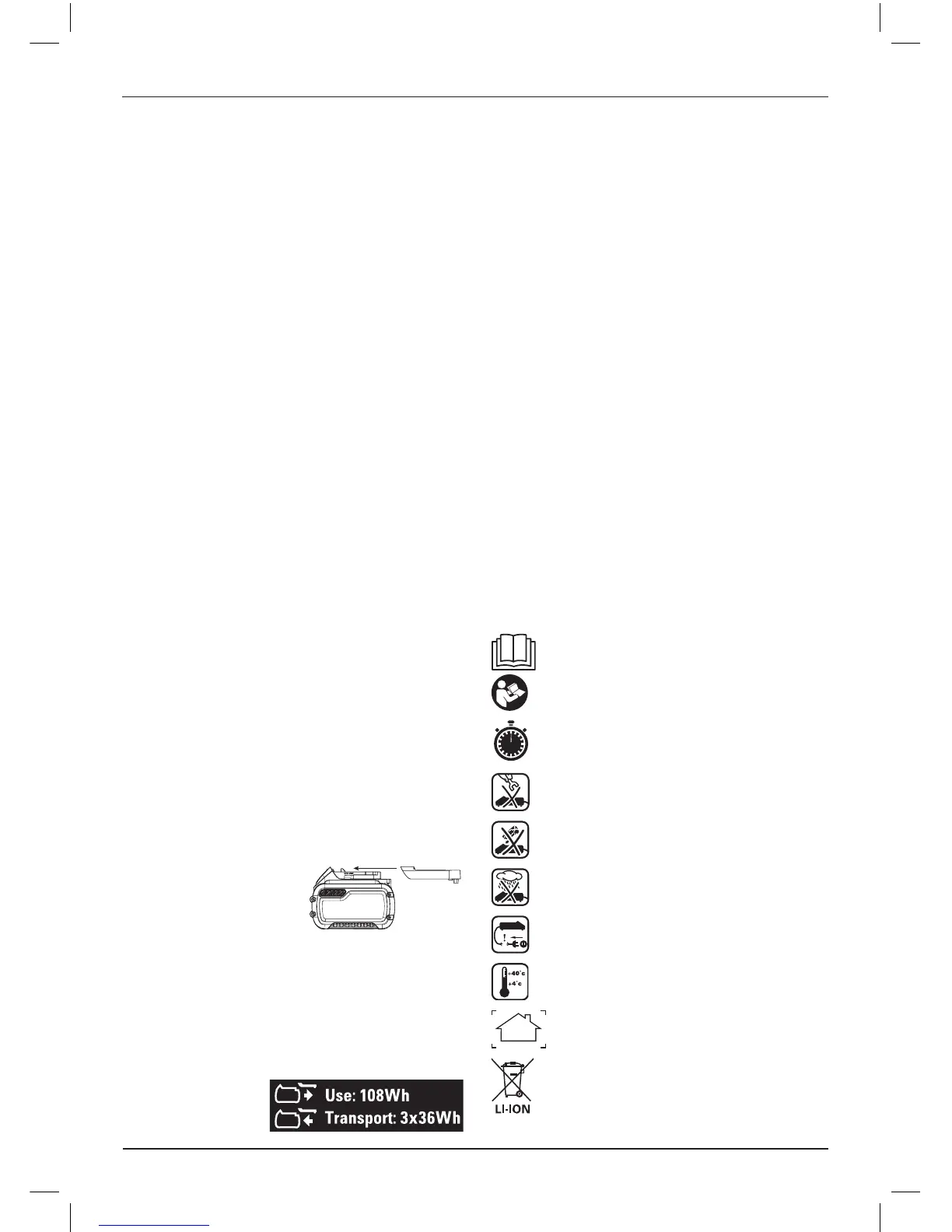19
English
each. The Use Wh rating indicates 108 Watt hours
(1battery implied).
Battery Pack
BATTERY TYPE
The DCS575 and DCS576 operate on a 54V
battery pack.
The DCB546 battery pack may be used. Refer to
Technical Data for more information.
Storage Recommendations
1. The best storage place is one that is cool and
dry away from direct sunlight and excess heat
or cold. For optimum battery performance and
life, store battery packs at room temperature
when not in use.
2. For long storage, it is recommended to store a
fully charged battery pack in a cool, dry place
out of the charger for optimal results.
NOTE: Battery packs should not be stored
completely depleted of charge. The battery pack will
need to be recharged before use.
Labels on Charger and Battery Pack
In addition to the pictographs used in this manual,
the labels on the charger and the battery pack may
show the following pictographs:
Read instruction manual before use.
See Technical Data for charging time.
Do not probe with conductive objects.
Do not charge damaged battery packs.
Do not expose to water.
Have defective cords replaced
immediately.
Charge only between 4 ˚C and 40 ˚C.
Only for indoor use.
Discard the battery pack with due care
for the environment.
(ADR). Lithium-ion cells and batteries have been
tested to section 38.3 of the UN Recommendations
on the Transport of Dangerous Goods Manual of
Tests and Criteria.
In most instances, shipping a
battery pack
will be excepted from being classified as a fully
regulated Class 9 Hazardous Material. In general,
only shipments containing a lithium-ion battery
with an energy rating greater than 100 Watt Hours
(Wh) will require being shipped as fully regulated
Class 9. All lithium-ion batteries have the Watt
Hour rating marked on the pack. Furthermore,
due to regulation complexities,
does not
recommend air shipping lithium-ion battery packs
alone regardless of Watt Hour rating. Shipments of
tools with batteries (combo kits) can be air shipped
as excepted if the Watt Hour rating of the battery
pack is no greater than 100 Whr.
Regardless of whether a shipment is considered
excepted or fully regulated, it is the shipper's
responsibility to consult the latest regulations for
packaging, labeling/marking and documentation
requirements.
The information provided in this section of the
manual is provided in good faith and believed to be
accurate at the time the document was created.
However, no warranty, expressed or implied, is
given. It is the buyer’s responsibility to ensure that its
activities comply with the applicable regulations.
TRANSPORTING THE FLEXVOLT™ BATTERY
The D
WALT FLEXVOLT™ battery has two modes:
Use and Transport.
Use Mode: When the FLEXVOLT™ battery stands
alone or is in a D
WALT 18V product, it will operate
as an 18V battery. When the FLEXVOLT™ battery
is in a 54V or a 108V (two 54V batteries) product, it
will operate as a 54V battery.
Transport Mode: When the cap is attached to
the FLEXVOLT™ battery, the battery is in transport
mode. Keep the cap for shipping.
When in Transport mode,
strings of cells are
electrically disconnected
within the pack resulting
in 3 batteries with a lower Watt hour (Wh) rating as
compared to 1 battery with a higher Watt hour
rating. This increased quantity of 3 batteries with the
lower Watt hour rating can exempt the pack from
certain shipping regulations that are imposed upon
the higher Watt hour batteries.
Transport Wh rating
EXAMPLE OF USE AND
TRANSPORT LABEL MARKING
indicates 3x36 Wh,
meaning 3 batteries
of 36 Watt hours

